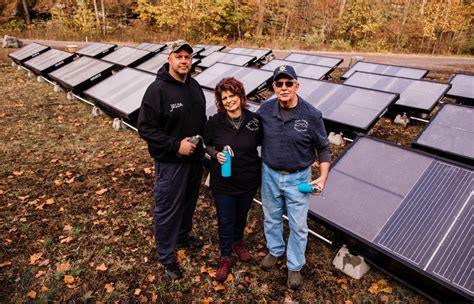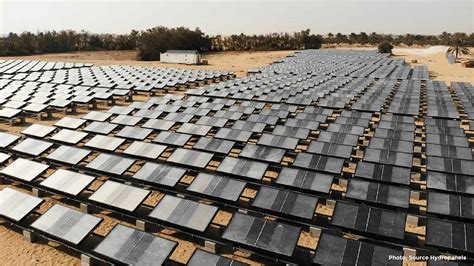Introduction to Hydropanels
Hydropanels are a revolutionary technology that can extract clean, renewable water directly from the air. Developed by the company Source Global, these innovative panels utilize solar energy to power a process that collects water vapor from the atmosphere and converts it into potable water. This technology has the potential to provide a sustainable solution to water scarcity in various regions around the world.
How Hydropanels Work
Hydropanels function by employing a combination of solar power, advanced materials, and atmospheric water generation technology. The process can be broken down into the following steps:
-
Air Intake: The hydropanel draws in ambient air using fans powered by solar energy.
-
Water Vapor Collection: As the air passes through the panel, a proprietary hygroscopic material absorbs water vapor from the air.
-
Solar-Powered Condensation: Solar energy is used to heat the hygroscopic material, causing the absorbed water vapor to be released as liquid water.
-
Water Purification: The collected water is then purified using a multi-stage filtration process, ensuring that it meets drinking water standards.
-
Water Storage and Dispensing: The purified water is stored in a reservoir within the hydropanel until it is ready to be dispensed for use.
Benefits of Hydropanels
Renewable and Sustainable Water Source
One of the primary advantages of hydropanels is that they provide a renewable and sustainable source of clean water. By extracting water from the air, these panels do not rely on traditional water sources such as groundwater, rivers, or lakes, which can be depleted or contaminated. This makes hydropanels a valuable tool in regions facing water scarcity or in areas where access to clean water is limited.
Energy Efficient and Environmentally Friendly
Hydropanels are powered entirely by solar energy, making them an energy-efficient and environmentally friendly solution for water generation. The panels do not require any external power source or grid connectivity, which allows them to operate in remote or off-grid locations. By harnessing renewable solar energy, hydropanels contribute to the reduction of greenhouse gas emissions associated with traditional water treatment and distribution methods.
Decentralized Water Production
Another benefit of hydropanels is their ability to provide decentralized water production. Unlike traditional water infrastructure, which often relies on large-scale treatment plants and extensive distribution networks, hydropanels can be installed directly at the point of use. This decentralized approach reduces the costs and energy requirements associated with water transportation and distribution, making it an attractive option for communities and businesses looking to improve their water security and resilience.
Adaptability to Various Climates
Hydropanels are designed to operate in a wide range of climatic conditions, from arid deserts to humid tropical regions. The technology’s ability to extract water from the air is not dependent on precipitation or the presence of surface water sources, making it a versatile solution for water generation in different environments. However, the efficiency of hydropanels may vary depending on factors such as relative humidity, temperature, and solar radiation.

Applications of Hydropanels
Residential and Commercial Use
Hydropanels can be installed on the roofs of residential and commercial buildings to provide a localized source of clean drinking water. This application is particularly valuable in areas where tap water quality is poor or where water shortages are common. By generating their own water supply, households and businesses can reduce their reliance on municipal water systems and improve their water security.
Agricultural and Irrigation Purposes
In addition to providing drinking water, hydropanels can also be used for agricultural and irrigation purposes. The water generated by these panels can be used to irrigate crops, support livestock, or maintain landscapes in water-scarce regions. By reducing the need for groundwater extraction or surface water diversion, hydropanels can help alleviate the pressure on local water resources and contribute to more sustainable agricultural practices.
Emergency and Disaster Relief
Hydropanels can play a crucial role in emergency and disaster relief efforts, particularly in situations where access to clean water is compromised. In the aftermath of natural disasters such as hurricanes, earthquakes, or floods, hydropanels can be quickly deployed to provide a reliable source of drinking water for affected communities. The panels’ ability to operate independently of infrastructure makes them a valuable asset in crisis situations.
Remote and Off-Grid Locations
Hydropanels are well-suited for use in remote and off-grid locations where access to traditional water infrastructure is limited or non-existent. These panels can provide a sustainable water supply for rural communities, eco-lodges, and research stations in isolated areas. By eliminating the need for water transportation or reliance on local water sources, hydropanels can improve the self-sufficiency and resilience of these communities.

Case Studies and Success Stories
SOURCE Hydropanels in Palau
In the island nation of Palau, SOURCE hydropanels have been installed to provide clean drinking water for local communities. The panels have helped alleviate water scarcity issues caused by the island’s limited freshwater resources and the impacts of climate change. By generating water from the air, the hydropanels have reduced the reliance on imported bottled water and have improved water security for the people of Palau.
Hydropanels in Schools and Hospitals
SOURCE hydropanels have been deployed in schools and hospitals around the world to provide a reliable source of clean drinking water. In Australia, a primary school in New South Wales installed hydropanels to reduce its reliance on the municipal water supply and to promote sustainability education among students. In the Philippines, a hospital in Cebu City implemented hydropanels to ensure a consistent supply of safe drinking water for patients and staff, particularly during water shortages.
Agricultural Applications in Kenya
In Kenya, SOURCE hydropanels have been used to support agricultural activities in water-scarce regions. The panels have been installed on farms to provide water for irrigation and livestock, reducing the need for groundwater extraction and improving the resilience of agricultural communities. By generating water from the air, the hydropanels have helped farmers adapt to the challenges posed by climate change and water scarcity.

Challenges and Limitations
Cost and Affordability
One of the main challenges associated with hydropanels is their cost and affordability. Currently, the technology is relatively expensive compared to traditional water sources, which may limit its widespread adoption, particularly in developing countries or low-income communities. However, as the technology continues to advance and production scales up, it is expected that the cost of hydropanels will decrease over time.
Maintenance and Lifespan
Like any technology, hydropanels require regular maintenance to ensure optimal performance and longevity. The panels must be cleaned periodically to remove dust and debris that can accumulate on the surface and reduce their efficiency. Additionally, the lifespan of hydropanels is currently estimated to be around 15-20 years, after which they may need to be replaced. Ongoing research and development efforts aim to improve the durability and lifespan of these panels.
Limited Water Production Capacity
While hydropanels offer a promising solution for water generation, their current water production capacity is relatively limited compared to traditional water sources. A single hydropanel can typically generate around 2-5 liters of water per day, depending on the environmental conditions. This means that a significant number of panels may be required to meet the water needs of larger communities or industries. However, as the technology continues to evolve, it is expected that the water production capacity of hydropanels will increase.
Future Outlook and Potential Developments
Technological Advancements
As research and development in the field of atmospheric water generation continue, it is expected that hydropanels will undergo further technological advancements. These advancements may include improvements in the efficiency of water extraction, the development of more durable and cost-effective materials, and the integration of smart monitoring systems to optimize panel performance. Such advancements will contribute to making hydropanels a more viable and accessible solution for water generation.
Integration with Other Renewable Technologies
There is potential for hydropanels to be integrated with other renewable technologies to create more comprehensive and sustainable water and energy systems. For example, hydropanels could be combined with solar photovoltaic panels to generate both water and electricity, or with rainwater harvesting systems to maximize water collection efficiency. The integration of hydropanels with other renewable technologies could lead to the development of self-sufficient, off-grid water and energy solutions.
Policy Support and Incentives
As governments and international organizations increasingly recognize the importance of sustainable water solutions, there may be growing policy support and incentives for the adoption of hydropanels. This could include subsidies, grants, or tax incentives to encourage the installation of hydropanels in residential, commercial, and agricultural settings. Additionally, the inclusion of hydropanels in water management strategies and sustainability goals could drive further development and deployment of this technology.
Frequently Asked Questions (FAQ)
-
Q: How much water can a single hydropanel produce per day?
A: A single hydropanel can typically generate around 2-5 liters of water per day, depending on the environmental conditions such as humidity, temperature, and solar radiation. -
Q: Can hydropanels operate in regions with low humidity?
A: Yes, hydropanels are designed to operate in a wide range of climatic conditions, including regions with low humidity. However, the efficiency of water extraction may be lower in areas with very low humidity levels. -
Q: Are the materials used in hydropanels safe for drinking water production?
A: Yes, the materials used in hydropanels are carefully selected to ensure that they are safe for drinking water production. The water generated by hydropanels undergoes a multi-stage filtration process to remove any impurities and meet drinking water standards. -
Q: How long do hydropanels last?
A: The lifespan of hydropanels is currently estimated to be around 15-20 years, after which they may need to be replaced. However, ongoing research and development efforts aim to improve the durability and longevity of these panels. -
Q: Can hydropanels be used in combination with other water sources?
A: Yes, hydropanels can be used in combination with other water sources, such as rainwater harvesting systems or traditional water infrastructure. The integration of hydropanels with other water sources can help maximize water collection efficiency and improve overall water security.
Conclusion
Hydropanels represent a promising and innovative solution for sourcing renewable clean water from the air. By harnessing solar energy and atmospheric water generation technology, these panels can provide a sustainable and decentralized approach to water production. The benefits of hydropanels, including their ability to operate in various climates, their energy efficiency, and their potential for use in a wide range of applications, make them an attractive option for addressing water scarcity and improving water security.
However, challenges such as cost, maintenance requirements, and limited water production capacity must be addressed to enable the widespread adoption of this technology. As research and development in the field of atmospheric water generation continue, it is expected that hydropanels will undergo further advancements, making them a more viable and accessible solution for water generation.
The successful implementation of hydropanels in various contexts, from residential and commercial settings to agricultural and emergency relief situations, demonstrates the potential impact of this technology. As governments, organizations, and individuals increasingly recognize the importance of sustainable water solutions, hydropanels are poised to play a significant role in shaping the future of water access and management.
By investing in the development and deployment of hydropanels, we can take a significant step towards addressing the global water crisis and ensuring a more sustainable and resilient future for all.

No responses yet